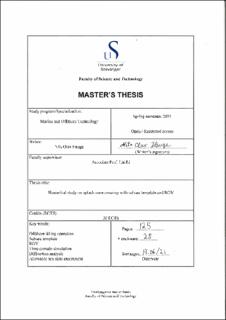| dc.description.abstract | External loads on a free-floating vessel affect the vessel responses in waves. DNV’s recommended practice for modeling and analysis of marine operations [1] categorizes lifting of an object above 1-2% of the vessel displacement as a heavy lift operation. Such operations have a non-negligible impact on the vessel responses. This type of operation is primarily lifting using the vessel crane. This study focuses on two different cases of lifting operations. The first case is a purpose-made vessel for transportation and deployment/recovery of a Remotely Operated Vehicle (ROV) at the stern of the vessel. The second case is installation of a subsea template (ITS) with an offshore construction vessel. Such operations are often done at a certain heeling or trimming angle induced by the weight of the lifted object. Realistic operational weather limitations for these types of operation are important both for safety reasons and economic reasons. It is therefore interesting to investigate the consequence of changing the vessels heeling and trimming angle when performing the lifting operations.
Installation of a subsea template typically involves overboarding, lowering through the splash zone, lowering down to seabed, and landing on the seabed. Deployment of an ROV is similar, but the overboarding phase is slightly different. The ROV will be brought overboard by the launch and recovery system, lowered through the splash zone and lowered further down to working depth. The common phase for these cases is lowering through the splash zone. This study focuses on crossing of the splash zone, which is considered one of the critical phases of a deployment operation due to the potentially large hydrodynamic forces.
Comparative response analyses of the vessels with and without an initial trimming or heeling angle are conducted. The hydrodynamic properties for both vessels have been acquired through frequency domain analysis in upright/even keel condition and with a certain angle of trimming or heeling. Time domain simulations of the cases, with the acquired hydrodynamic properties, are used to study the dynamic responses of the system.
In addition to addressing the differences between simulating the deployment operations with response amplitude operators for upright/even keel position and a certain angle of trimming or heeling, the thesis discusses the differences between running the template deployment simulations as a coupled and uncoupled model.
The results indicate that waves arriving parallel to the axis that the vessel is rotated around generates larger responses for both vessels after being trimmed/heeled. Since the ROV deployment case has a criterion related to horizontal motion the larger responses cause lower allowable sea states for the trimmed case. The allowable sea states for the ITS deployment increases for the case with an initial heeling angle. The uncoupled case highlights the importance of the vessels ability to adjust to the motions of the lifted object, as the allowable sea state decreases. | |
